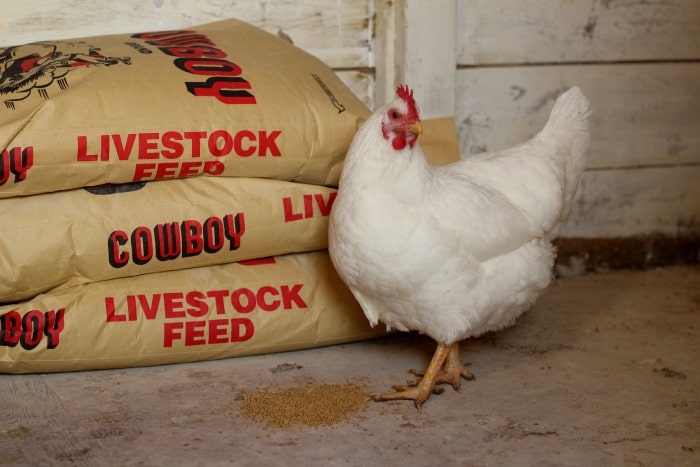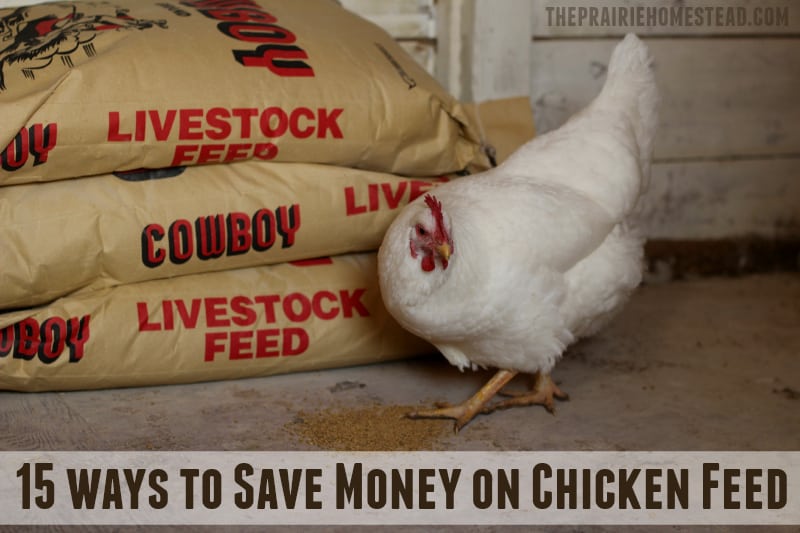15 Ways to Save Money on Chicken Feed
It’s a heartbreaking moment…
When you first realize your homegrown eggs are costing you more than what you’d pay for eggs at the store…The current state of mass food production has duped us into believing things like milk, eggs, and grains cost much less than they actually do or should.
For example: Even though we have our own milk cow, our milk technically costs me MORE than it would to simply buy a gallon at the grocery store.
The good news? Saving money isn’t the primary reason we’ve chosen to own a cow. For us, it’s really about the quality of the product; our milk is fresh, beyond organic, and wonderfully raw. Not to mention owning a cow just plain makes me happy, so it’s a quality of life thing for us as well.
Chickens and eggs fall into the same category. While it depends on feed prices in your area, I’m still going to venture to say if you are looking for “frugal” eggs, you’ll probably be better off to buy eggs from the store. But, that’s not the reason most of us keep chickens, right? We love the bright yellow yolks, the satisfaction of watching the hens peck around the yard, and all that comes with chicken-ownership.
However, if you experienced sticker-shock the last time you walked into the feed store, take heart! There are plenty of ways to save money on chicken feed, AND boost your flock’s nutrition in the process. This list will help you get started—>
15 Ways to Save Money on Chicken Feed
1. Shop around. When I started calling different feed mills, I was surprised at the huge difference in prices. Just remember– cheaper isn’t always better, and if you are feeding an ultra low-quality feed, it can be very hard on your birds. Never sacrifice your chickens’ health just to save a buck.2. Mix your own feed. I say this with a wee bit of hesitation, since depending on your situation, it may actually be MORE expensive to mix your own feed… However, I do suggest finding a recipe you like (all my homemade chicken feed recipes are in my Natural Homestead book), and then shopping around with local feed stores to see how much it would cost for them to mix it for you. Also, don’t forget to check with the local farmers in your area. Sometimes they’ll have older grains sitting around that aren’t fit for human use, but would be fabulous for your flock.
3. Buy feed in bulk. I buy everything in bulk, including my chicken feed. Often feed stores will give you a cut if you purchase a pallet of feed, rather than just a bag or two. Another trick is to split a large order with a friend. My one caveat is this: chicken feed which has been ground/processed/cracked, rapidly looses nutrition as it sits. It’s probably not a good idea to purchase a year’s supply at a time, unless you are using a recipe that calls for whole grains–they are much more shelf-stable.
4. Ferment your chicken feed. Fermenting your chicken feed greatly increases nutrition, and decreases the amount they eat. The same goes for sprouting.
5. Stop feeding free-choice. This is actually a topic with a bit of debate surrounding it… (Have you noticed everything causes a debate these days?) While I like the thought of allowing my flock to self-regulate, it can be a problem if you have lots of rodents. Rats and mice think free-choice chicken feeding is the best thing ever, and if you struggle with rodent problems in your coop, it’s likely your all-you-can-eat grain buffet is to blame. This problem can be avoided by only feeding as much as your chickens can eat in one day.

6. Free range as much as possible. I realize this isn’t possible for everyone, but if you can, allow your chickens to roam around your yard. Not only will this greatly supplement their diet, it can also help to control bug populations, and keeps them from becoming bored. Plus, there is something so soothing about watching chickens scratch around your front porch.
7. Bring the yard to the flock, if the flock can’t roam the yard. When my hens must stay confined to their pen in the summer months (usually because they are destroying my almost-ripe tomatoes), I like to pick large handfuls of weeds or grass and toss them over the chicken-run fence. The girls definitely enjoy rummaging around in the green matter. I also like to take a bucket to the garden with me when I weed, and I collect all the weeds in the bucket and transport them to the flock as well. (Although I don’t have near as many weeds as I used to, thanks to my deep-mulching adventures!)
8. Ask for leftover vegetable and fruit scraps at the grocery store. Not all stores will allow this, but ask if you can have the wilted lettuce, squishy tomatoes, and bruised apples. Some folks also collect stale bread items from bakeries, but I personally avoid this. Many of the bread items sold in stores like donuts, breads, rolls, or muffins are made with heavily processed ingredients and additives. They might be okay for the occasional treat, but they aren’t something I’d recommend feeding on a regular basis– just as humans shouldn’t eat them as the bulk of their diet.
9. Grow your own feedstuffs. Grains, cover crops, greens, sunflowers, and various veggies are good places to start.
10. Grow duckweed. I haven’t tried growing my own duckweed yet, but I’m totally intrigued! Duckweed is a high protein plant that can be fed to a variety of animals, including chickens. If you’re a duckweed grower, please leave a comment and share your wisdom!
11. Raise soldier grubs. As tough as I like to think I am, I must confess I’m still not quite ready to tackle the whole concept of raising grubs/larvae for my birds. Do I think it’s incredibly smart? YES. Do I think it’s a fabulous way to create low-cost, high-protein feed? YES. Do I want to get up-close-and personal with maggots? Eh, not quite yet. If you’re braver than me, my chicken-keeping idol, Harvey Ussery, has a chapter in his book (affiliate link) devoted entirely to cultivating soldier grubs.
12. Offer leftover milk and whey. If you own dairy goats, cows, or sheep, you are familiar with the feeling of drowning in milk. When you’re floating in milk and have made all the homemade yogurt and mozzarella cheese you can handle, consider sharing your excess with your chickens. Leftover milk and whey are full of protein and most flocks will enjoy the treat. For an extra boost of probiotic nutrition, clabber your raw milk by allowing it to sit out at room temperature for several days until it begins to thicken. (Don’t attempt this with pasteurized milk– you will not have the same results.)
13. Save kitchen scraps for your flock. I keep a small bucket on my kitchen counter at all times and continually toss in bits of leftover bread, celery ends, carrot peelings, watermelon rinds, and more. It’s a feeding frenzy when I show up at the coop. My chickens have even been known to chase me down in the yard when they see me carrying any sort of white bucket. It’s insanely satisfying to watch your birds turn kitchen waste into orange-yolked eggs.
14. Sell eggs. Yeah, I know this isn’t exactly a way to save money on feed, but selling excess eggs is a wonderful way to offset feed costs, and make your chickens pay for themselves. Plus, there is always someone wanting farm-fresh eggs!
15. Cull non-productive members of the flock. I know many of you keep chickens as pets, and that’s great. But if you are truly trying to cut costs, it may be time to turn non-producing hens into nourishing chicken soup. I know this thought might cause some of you to recoil in horror, but keep in mind this is exactly what great-grandma would have done.
More Chicken Resources
- Natural Homestead– my latest eBook that’ll help you mix your own chicken feeds, create herbal supplements, fight garden pests naturally, and lots more.
(This is not a paid endorsement or affiliate arrangement - we just like what she has to say on her blog )
..

No comments:
Post a Comment